Crossdressing Guideline for Improving Your Feminine Deportment
Have you ever noticed that there are significant differences in masculine and feminine body language; how men and women move, sit and stand? Lots of us don’t notice these differences or aren’t mindful of them unless they are pointed out.
I wasn’t fully aware of how masculine my normal gait was until it was pointed out to me. Retraining our unconscious habits can be very difficult. Let me try to help make you more aware of the differences between how men and women walk, stand and sit; then you can try to observe your own movements and practice how to have a more feminine deportment.

Some of us like to just be alone with our feminine self; after all, when I am dressed at home alone, I’m not worried about being clocked or embarrassed if I’m recognized. Dressing and going out in public is another matter altogether. It brings on a whole new set of challenges; most notably, being able to pass as a woman.
Sometimes, even if our makeup and clothing are perfect, our body language can detract from our femininity. But for me, even if I’m home alone and dressed, I want to get the most out of my time as a girl. I certainly won’t get girled up and then lounge around watching a football game and eating junk food. I want to be gracefully feminine from top to bottom, inside and out. If only catching a glimpse of my manly walk as I go past a mirror in girl mode, or slouching a bit can ruin my time en femme and get me down, imagine what could be going through the minds of others as we go past them in public.
Let me share some of my advice about how the way we stand, sit and walk can be made more convincingly feminine. Follow these tips and you’ll be on your way to acting as womanly as you can dress!
TABLE OF CONTENTS
1. Standing
Even something this simple can be very revealing. Men and Women definitely stand with different postures and when you look for them, you can spot the differences easily. Sometimes I try to observe how men and women stand up on the subway to work or in a shop. Try it and you’ll see.
● Difference between male and female
A man tends to stand straighter and rigidly. They’ll keep their legs evenly apart, and keep an equal amount of weight on each foot. Stand in front of a mirror normally and you’ll see; you are likely to have your feet spread apart, and you won’t be able to tell which foot is carrying more weight than the other and every part of your body is directly opposite the mirror. Some of us cross our arms; I have a particularly bad slouching habit that is fairly common.

Women look a bit more relaxed when standing. One of the first things I noticed was that, when standing naturally, a woman will often have more weight on one foot, and will shift it from time to time. Because of this their stance is less rigid. They’ll also keep their feet closer together.
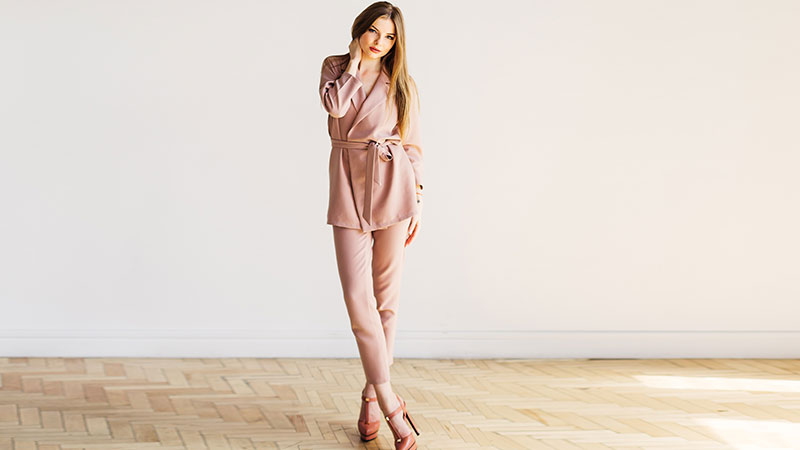
Something that I noticed about this stance is that it enhances their curves, and results in sexy subtle movements when a woman moves her weight from one foot to the other.
● Avoid masculine postures
DON’T keep your feet too far apart.
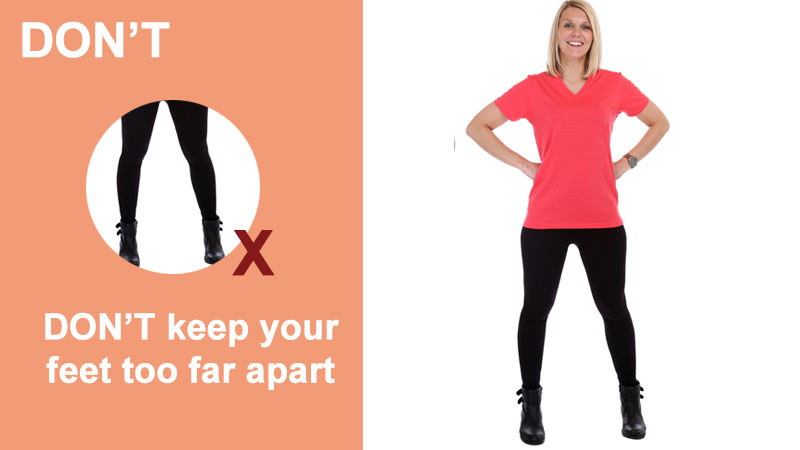
Doing this deemphasizes feminine curves and reinforces the image of a flat straight silhouette running from your armpits to your feet.
DON’T hunch your back or slouch over.

This isn’t a graceful position and starting graceful movements from this position will be difficult. We want to be Esmerelda, not Quasimodo.
DON’T cross your arms over your chest.

This isn’t something women do often, if ever. Doing this can make you appear hostile or defensive. Also, you’ll cover your breasts.
● Develop feminine stance
Try to do some stance training.
There are a number of things you can do to train yourself to have a more feminine posture.

A classic exercise is to stand with a book balanced on your head. I find this one to be pretty challenging, you’ve got to keep your head steady and back straight. You’ll want to pick a hardcover book. Nothing too heavy; it can hurt if it falls and hits your toes.
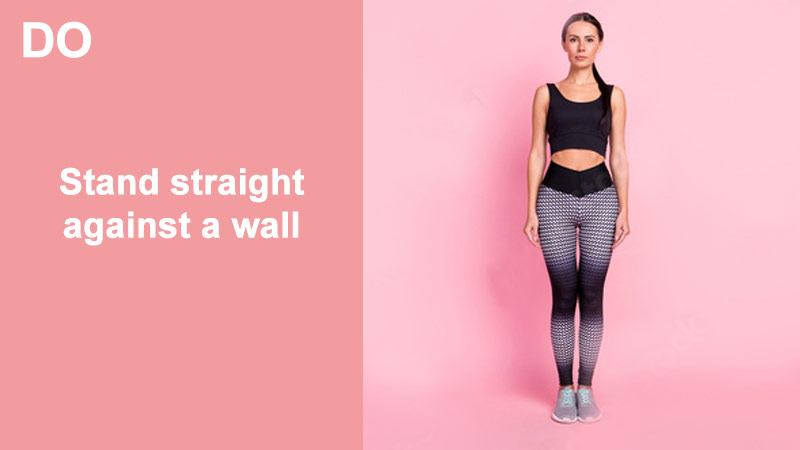
Something that I think is a bit more comfortable to do for training is to stand straight against a wall. You’ll want to keep the back of your heels about 2 inches from the wall and your feet 2 to 4 inches apart. You should be able to slide your arm into the space between the wall and the small of your back. Practice that as a resting position; add the book if you’d like some extra challenge. This exercise will help prevent slouching and emphasize your feminine posture. It’s also a great starting position to walk out of and be conscious of your posture.
Be mindful of your hands.
Men and Women will often do different things with their hands and arms when standing without thinking.
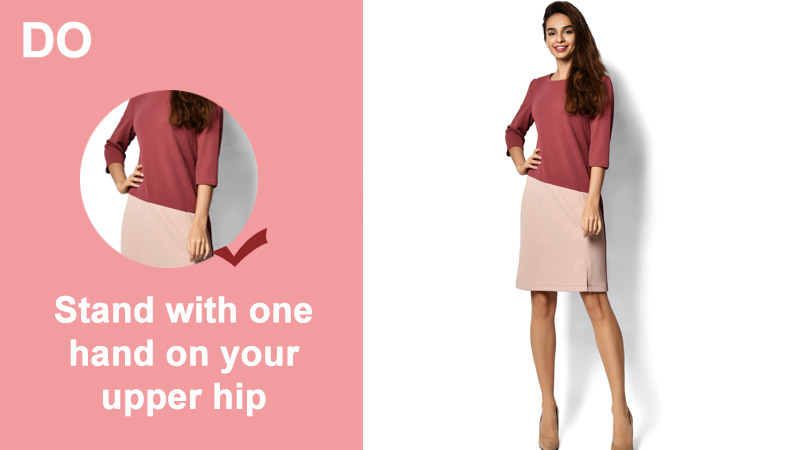
You should stand with one hand on your upper hip. This will show off curvier hips and is a more feminine position than putting your hands in your pockets.
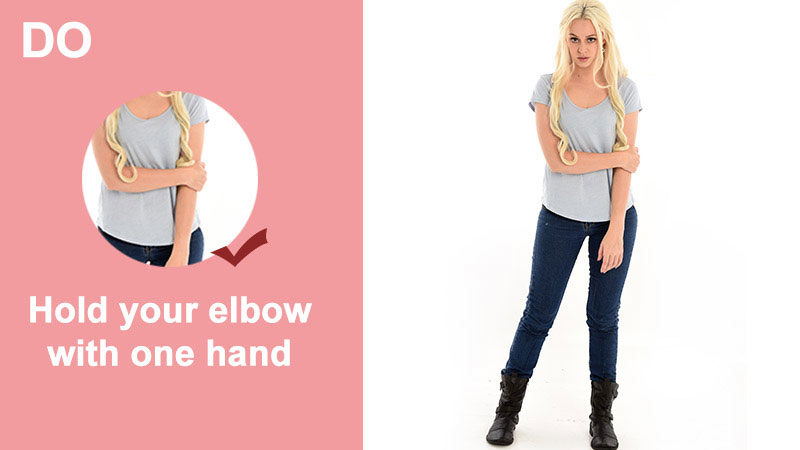
To avoid crossing your arms at chest height, try holding your elbow with one hand. Some other tricks would be to loosely extend your arms in front of you and hold your wrist, or lightly interlock your fingers and keep your arms in front of you with your hands just below your beltline.
2. Walking
This is perhaps the most striking way that male and female deportment differ. If you see a couple walking in a shopping mall or on the street, try to take note of the small but significant differences. When you’re walking instinctively, you’re probably taking quite long steps and your toes will be pointing up at an angle when your foot hits the ground. Try that wearing a pair of 4-inch-high heels!
Most of these walking exercises are just an extension of the standing ones we read about above. Now we just need to practice keeping that standing posture while moving. A good place to start any of these techniques below is to stand against a wall. Keep your chin line parallel to the ground, chest out, shoulders back, and take your first feminine steps forward.
To develop a more feminine gait, try these simple tricks:
● Take shorter steps
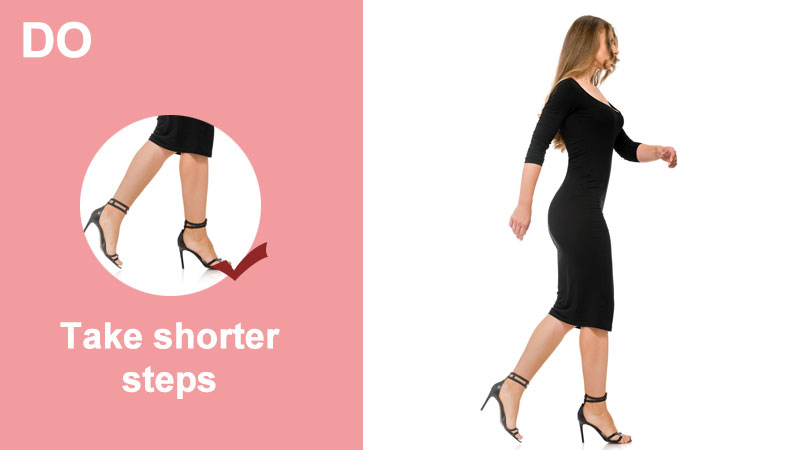
You’re going to want to be mindful of how long each one of your strides is. The longer your stride, the more likely you’re going to land on your heel and give yourself away. Shorter steps ensure that you can place your foot flat on the ground. You’ll also be able to keep your balance better with a smaller stride.
● Keep one foot in front of the other
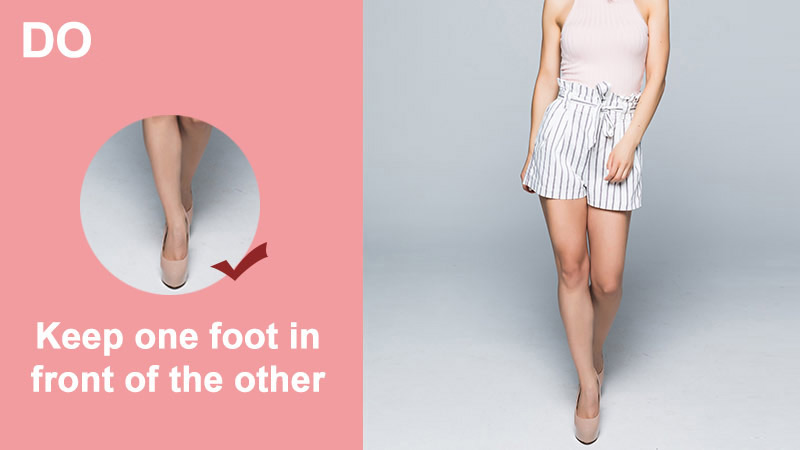
Women will often walk with shorter strides and also keep their legs and feet closer together when they walk. When you’re walking place one foot directly in front of the other. Think about it this way; If you were to draw a straight line about two inches wide in front of you on the beach; a feminine walk would have at least a portion of each footprint on that line.
Be careful that you don’t overdo it. You don’t want to put your left foot on the right side of the line, or your right foot on the left side. Doing that can risk your walk being too exaggerated and looking like a drag queen and not a genuine woman. Watch a few episodes of Drag Race and you’ll see.
When you combine this with the smaller steps above, you’re more than on your way to walking like a graceful feminine woman. The smaller more even steps taken in a straighter line will result in less of a ‘rolling’ walk, and more of a ‘bouncing’ walk. Try both with your nicest heels, look in the mirror and marvel at your new womanly walk.
● Swing your arms

You probably do this normally now when you walk now. Because of the longer and wider strides that men make, more side-to-side movement is generated. Take a brisk walk around and you might notice what I mean; your arms will likely swing at an angle going across your body.
So how can you restrain this innately male motion to be more feminine? If you leave your arms hanging from your shoulders motionless, you risk looking awkward and stilted. Swing your arms too far, too much or too quickly and you risk drawing attention to yourself because of unnatural movements.
This is where observation is key. Try watching some runway fashion shows; watch how the models use their arms and try to use them to gauge your own movements. Try to keep your arm movements in sync with your legs. Here’s the really difficult part; try to retrain your arms to swing to about a 15 to 20-degree angle. Imagine a clock face; you’re standing facing the ‘3’ and your arm is the minute hand dangling down on the ‘6’. You’ll want to keep your arm swing in between the ‘5’ and the ‘7’.
Most important here is to remember to keep your arm movements natural. If you’re practicing and you don’t’ feel like it’s working out, try holding onto a handbag on one side and place your other hand on your waistline. Don’t worry, practice makes perfect.
I know this part might be a little hard for you, if you still don’t know how to swing your arms, this video can tell you better.
3. Sitting
Just like standing and walking, men and women sit down differently. I know that at the end of the day, I like to plop down in a comfy chair, put my feet up, lean back and relax. Sometimes when I’m traveling to work on the train, sitting at my computer or looking at my phone, I often like to lean forward and keep my elbows on my knees. Needless to say, these are very typical male sitting positions, and all of the movements to get me there are also typically male. If I tried this en femme, I’d be immediately clocked as a man in a dress.
Sitting in a feminine manner can be very difficult because it involves a lot of coordinated actions. You’ve got to move up and down and from side to side; you’ve also maybe got to keep your balance on a pair of heels. When you think about it all happening at once, it’s not easy.

Follow some of this advice to improve your ability to sit in a more feminine position.
● Prepare to sit
I know this point sounds odd at first glance. The idea here is to keep your posture and movements as feminine as possible as you move down towards where you’ll be sitting.
The first thing, I’ve noticed is that women tend to take a quick glance at the chair they’ll be sitting in before they sit down. This isn’t a bad idea; get a feeling for how much you’ll need to bend your legs and move downward.
If you’re wearing a skirt or a dress, smooth out the front before sitting and if it’s of a shorter length, smooth it out again with the palm of your hand once you’ve sat down. Be slow with your movement into the seat; you don’t want the chair or couch to make any sort of loud noise.
● Only use 2/3 of the chair

Don’t use the whole seat. Very rarely will a woman sit and lean back in a chair. Remember the lessons we learned earlier about keeping a feminine posture; sit down and keep your back straight, shoulders back and your chin line parallel to the floor. This posture will look more demure and feminine than leaning all the way back or forward.
● Legs together

This is pretty essential. It’s called manspreading for a reason; women don’t do it! Secondly, having your legs far apart gives anyone a good view up your skirt and they can have a good look at your panties.

Keeping your legs together will also give you a more womanly profile. It’s also a nice place to keep your hands; just place them one on top of the other and rest them on your knees.

The general idea here is to always have your knees touching when sitting. This is true if your legs are crossed or not. Women will usually cross their legs knee on top of the knee.
Men usually do ankle to knee. If your legs are crossed, don’t move them too much.
● Legs slanted
There are two names for the poses that will help you keep your legs in a more feminine position. Both are the same in principle; they are ‘the Duchess slant’ and ‘the Cambridge slant’. In the same way that you should remember to keep knees together, keep your ankles together. Simple enough, right?

Move your feet to the side of the chair, ankles together, just next to a chair leg. This is called ‘the Duchess slant’. There is also a similar position called ‘the Cambridge slant’. This is nearly the same position, just with your legs crossed at the ankles. Keeping your shins in this slanted position ensures that your thighs remain parallel with the floor; for those of us with very long legs, like me, both of these positions will help appear more feminine. Keeping that angle is another way to keep your modesty and prevent those curious from trying to catch a glimpse of your panties.
If you want to learn more about elegant female sitting postures you can watch this video below.
Feminine deportment is so very hard to master. We’ve covered some of the basics here. So much of our body language is innate, and it’s really hard to almost have to retrain our bodies to stand, walk and sit differently when dressed up. I know this can seem overwhelming and being acutely aware of our movements can induce anxiety. Try choosing an area to work on each time you transform into your girly self; maybe 20 minutes of standing beside a wall, or keeping a feminine posture when reading a book. Following these simple tips can really help you feel and act like the woman you’re trying to be. Don’t get discouraged if you notice you’ve made a mistake that means you’re learning!
Once you’ve developed some awareness of how our male habits can affect our feminine personas when dressed up, we can work to minimize these little things that reduce our femininity. With enough practice, they can become second nature! Trust me, developing these habits will make you really feel more feminine and you’ll be so proud of that woman looking back at you in the mirror when you’ve mastered them.
Please share any more tips you have to make your movements more feminine in the comments.
Written by Maproteus
Tagged With:Crossdressing Feminine Deportment , Feminine Movement
3 comments
Leave a Reply
- Going Out en Femme – How to Get the Breakthrough
- Gay Crossdresser vs. Sissy Men: What’s the Difference?
- How to Become a Feminine Man: Fashion & Personality
- Sissy Training: A Complete Beginner’s Guide
- First Visit to a Transgender Bar: How to Navigate Your Way
- How to Determine if You’re a Transgender
- The Truth About Crossdressing: History, Meaning, and Misunderstandings
- Joining TVChix: The Online Space That Changed My CD Experience
- Praise vs. Degradation: What Fuels Your Feminine Journey?
- How to Support and Navigate Life with a Crossdressing Husband
- How Crossdressing Helps Me Discover Different Sides of Myself
- The Freedom of Age: Why Mature Crossdressers Shine Brighter
Established in 2009, We are a recognized manufacturer and seller of professional crossdressing products.
It is our aim to become not just the most creative manufacturer but also a very considerate seller, as we provide the best quality products for crossdressers all around the world.






















 Breast Forms
Breast Forms  Body Suit
Body Suit  Realistic Mask
Realistic Mask  Femini Girdle
Femini Girdle Hip & Butt Enhancement (8)
Hip & Butt Enhancement (8) Penis Prosthesis
Penis Prosthesis Fake Muscle
Fake Muscle Bikini
Bikini  Wig
Wig  Corsets
Corsets Course
Course service@roanyer.com
service@roanyer.com +8618652200711
+8618652200711 Facebook
Facebook YouTube
YouTube Twitter
Twitter Instagram
Instagram





Very informative
Thank You
love this x
This is an EXCELLENT tutorial. I’ve been crossdressing for decades and even I learned something new by reading this! Great work Roanyer